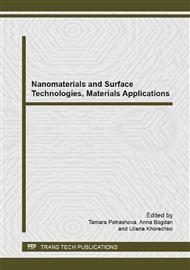[1]
M.A. Shtremel, The strength of alloys. Part II. The deformation. MISIS, Moscow, (1997).
Google Scholar
[2]
B.A. Kolachev, V.A. Livanov, A.A. Buhanova, The mechanical properties of titanium and its alloys, Metallurgiya, Moscow, (1974).
Google Scholar
[3]
P.V. Geld, Hydrogen in metals and alloys, Metallurgiya, Moscow, (1974).
Google Scholar
[4]
V.P. Baranov, Definition of effective factors of diffusion of hydrogen in deformed high-tensile steels, Modern problems of science and education, No. 1 (2007) 38-41.
Google Scholar
[5]
Yu.R. Kolobov, The grain-boundary diffusion and the properties of nanostructured materials, Nauka, Novosibirsk, 2001, p.232.
Google Scholar
[6]
N.I. Noskova, R.R. Mulyukov, The submicrocristalline and nanocristalline metals and alloys, UB RAS, Ekaterinburg, 2003, p.278.
Google Scholar
[7]
N.N. Nikitenkov, Yu.I. Tyurin, I.A. Shulepov, E.N. Kudryavtseva, A Plant for Studying Radiation and Thermal Desorption of Gases from Inorganic Materials, Instruments and Experimental Techniques, Vol. 52, No. 6 (2009) 865-870.
DOI: 10.1134/s0020441209060207
Google Scholar
[8]
Yu.I. Tyurin, A.M. Semenov, N.N. Nikitenkov, The high-vacuum method of measurement of diffusion coefficients for light isotopes in metals, Journal of Surface Investigation. X-ray, Synchrotron and Neutron Techniques, No. 5 (2004) 90-93.
Google Scholar
[9]
P.V. Geld, R.A. Ryabov, E.S. Kodes, Hydrogen and the imperfection of metal structure, Metallurgiya, Moscow, (1979).
Google Scholar
[10]
N.N. Nikitenkov, E.N. Kudryavtseva, A.M. HashHash, The thermo stimulated desorption from samples saturated with atomic and molecular hydrogen, Proceeding of XIX International Conference on Ion-Surface Interactions (ISI-19), No. 1 (2009) 152-154.
Google Scholar
[11]
A.A. Airapetov, L.B. Begrambekov, S.V. Vergazov, A.M. Zaharov, A.A. Kuzmin, Ya.A. Sadovskiy, P.A. Shigin, The problems of atomic science and engineering, Ser. Termoyaderniy sintez, No. 3 (2009) 25-29.
Google Scholar
[12]
B.A. Kolachev, O.P. Nazimov, L.N. Zhuralev, The hydrogen diffusion in titanium and β-titanium alloys, Non-ferrous metallurgy transaction. News of higher schools, No. 4 (1969) 104-109.
Google Scholar
[13]
N.N. Nikitenkov, Yu.I. Tyurin, T.I. Sigfusson, E.N. Kudryavtseva, V.S. Sypchenko, I.V. Dushkin, V.D. Khoruzhii, G.P. Grabovetskaya, E.N. Stepanova, N.V. Chistyakova, Features of the Plasma Saturation of Nanocrystalline and Coarse-Crystalline Titanium Samples with Hydrogen and Deuterium, Bulletin of the Russian Academy of Sciences: Physics, No. 76 (2012).
DOI: 10.3103/s106287381206024x
Google Scholar


